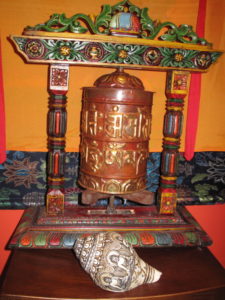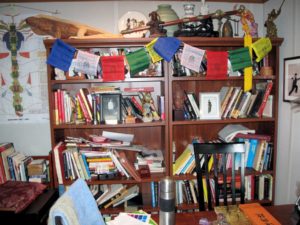By the time you read this, I will be in Egypt. I am looking forward to a few things but I really do not know what to expect. A place can change radically overnight. You have an image or experience of a city in your head and when you return, you are disappointed and frustrated or elated and inspired. Things do not stay the same. Of course, there is always that exceptional surprise if one is open to the wonder. I met a “Guardian of the Temple” in Karnak who demonstrated an important, probably secret, transmission, I had mystical experiences in the Queen’s Chamber (closed to the public) and in Cairo. Sometimes some Egyptian images would slip by, a few of them in dreams. I was told by several women that I had past lives in Egypt. One of them, a young woman, accused me of rejecting her; she said she was my student in ancient Egypt. I was invited to dinner by a group of healers in Heliopolis, the only man in the party, when she met me at the door and confronted me. I kind of stammered that I did not remember, it’s been so long. An older woman, the sister of my friend Amira, said I was a scribe. Another said I was a priest. These encounters still resonate in my memory. (Nobody has said I was a pharaoh.):) You can read about my other experiences in Egypt in the essay “Letter from Cyprus” in the Writings section of the website.
There is a long travelog in poetry form written in 1996. I’ve decided to include it here as a part of the different stories, fictitious or not, I’ve written over the years and featured in the website. It’s more about the mundane, the small experiences – many aggravations — one goes through from airport to airport. Reading it again, I realized a few of the friends I mentioned have passed away. There’s a handful of poems in the Poetry section, drawn from a collection written in 2001.
There is also a small gallery of the power spots I have visited. If you are interested in this kind of pilgrimage, go to “Opening Your Body to Nature” in the Writings section of the website. This is a simple way to connect to Nature and the environment, to feel the energy of the earth.
Quote, Unquote
Zhang Sanfeng, legendary founder of Tai chi chuan, recommends:
Performing sword movements in the moonlight because this would “enliven the spirit” (zeng shen)
Practicing Taijiquan in the dark of night because it “increased essence” (yi jing)
Climbing a mountain on windy nights because it “broadened qi” (zhang qi)
Studying and reading scriptures on rainy nights because it “illuminated the mind” (ming xin)
Sitting in meditation at midnight because it would bring “clarity to one’s nature” (jian xing).
He said that these five practices were the essence of Taoist self-cultivation.
— from “Refining the Elixir: The Internal Alchemy Teachings of Taoist immortal Zhang Sanfeng” by Stuart Alve Olson (Valley Spirit Arts)
There’s no credible evidence that Zhang Sanfeng lived or that he invented Tai chi chuan either or wrote those treatises attributed to him. Very often we are faced with myths and legends, fabrications of folks who are prone to make up stories about their idols, each story getting more and more exaggerated as time passes and as it is repeated and embellished. But in many cases the legend is really more interesting than the facts. It is more interesting to read about a master who was born in the mountains and grew up in Shaolin temple in China than about a doppelganger who was born and studied martial arts with a Chinese chef in Brooklyn.
I have read a lot of martial arts “history” – Boddhidharma and Zhang San Feng are just two of the many legends. Well, they were in the remote past, so perhaps the fake narrations could be excused. But the relatively contemporary writings about the famous Cheng Manching could not even get the facts about him straight. Many of the claims are not even consistent.
I advise a modicum of skepticism when it comes to stories about heroes and styles, especially those in the martial arts. A wu-shu master does an acrobatic move and before you know it, he is reported to have the ability to fly. A taijiquan teacher can control the movements of a student from a distance and when somebody tells the story he is capable of manipulating a whole audience of 1000 people. I suspect that there is a programming in our DNA that leads us to exaggerate and fantasize. It seems like we prefer fairy tales to realistic, down-to-earth and factual stories about ordinary people. People often prefer to leave their humdrum life and escape to a fantasy world of their own making.
To me, it is really simple. If you are going to claim a lineage, for instance, produce credible documents to establish the concatenation of events: who originated the style, what was included in the curriculum, where did the curriculum come from, how was the style handed down to the different generations? Very often what we have is just what George Barnard Shaw called dogmatic repetition. In many instances, the stories are just stories. Who invented Tai chi chuan? Who created Shaolin? How did the styles evolve? Is there a reliable history in which every claim is backed by a proof?
*“People forget that yama and niyama (the first two branches in the list of 8 yogas in the Sutras of Patanjali) form the foundation, and unless it is firmly laid, they should not practice postures (asanas) and breathing (pranayama) exercises. In India and Europe, I came across some three hundred people who suffered permanently from wrong practices, the doctors on examination found that there was nothing organically wrong and consequently could not prescribe.”
— Statement by Shree Purohit Swami in his commentary on the Yoga-Sutra. Quoted in the book “The Essence of Yoga: Essays on the Development of Yogic Philosophy from the Vedas to Modern Times” by George Feuerstein, Ph. D and Jeanine Miller (Inner Traditions International: Vermont 1998)
I’ve read many books about the popularization of hatha yoga/asanas in the West. I have often wondered first if any studies have been made to see the effects, positive or negative, on the practitioners. It looks like just about anybody can take a class in yoga. I wonder if there is a screening or an initiation at all before anybody is allowed to take lessons.
*Many of my contemporaries have passed away. Just last year alone saw the death of 3 of my friends. One had a serious stroke and ended up in the hospital for two weeks before he was discharged. We are going, one by one. Some of these people I admired and loved. When I hear about their demise, I sit down and think about how they lived, what they have done, what they have contributed to the world. Sometimes, I am sad. This or that person died too early or did not fulfill his potential or his destiny. But I try to let them go. Saying goodbye to a loved one is definitely difficult. We cannot hold back tears, we want the deceased to come back and stay. It’s something I do not like to do. We should let them go. Death isn’t such a bad thing, especially when a person, like one of my close friends, a poet an writer, has suffered prolonged illness. If you believe that death is the end, it may be difficult to comfort you. If you believe that there is a life after death – in some kind of a heaven or reincarnation – death may be easier to accept. We want permanence and eternity in life: we want love to continue, we want happiness not to end. Even when love and happiness have ended, we try to revive and hold on to them sometimes with terrible and fatal results. But as the Hindus, Buddhists and Daoists believe, much of life is impermanent, life is like a bubble, the seasons or the phases of the moon. Nothing really lasts. We want to hold on to something or somebody. We forget that we, too, have to go someday. But what is real – the Soul or Spirit, the Self, the Consciousness – never dies. We transition in the bardo/the in-between. The last couple of years I have read books about death and dying. I’ve done it not out of a morbid fascination (fear or love) with death but with a realistic expectation that at my age (78) I really do not have much time here on earth.
I accept the fact that it is attachment that makes us suffer: holding on to something or to somebody when we know that they’ll have to go sometime.
 *I’ve announced a few times before that I am giving away my possessions – books, first of all (please see the photos of the donations I’ve made to the Carlos P. Romulo Memorial Library and Museum in Tarlac City, my hometown), and eventually my swords, artifacts, paintings, statues, jewelry, buddhas. I’ve featured a few of them on my website every now and then. There is a 7-foot statue of Shiva, the Lord of the Dance, I acquired 2 years ago from Two Buttons in Frenchtown, NJ. The original owner, a Brazilian who married a famous writer, sold it to me at a discount. I told his manager that I will give it a home and that he can visit anytime. I was lucky that the owner of Two Buttons brought the price down because I could not afford the original price of $6500. Even at its discounted price I still could not afford it. I paid in installment. I’ve tried to study the different parts of the statue. I meditate on it. I light incense every time I am in the basement. In the 1990s I had a 2-foot tall Shiva when I was in Boston. I gave it to one of my students when I left New England for Lake Harmony, Pennsylvania.
*I’ve announced a few times before that I am giving away my possessions – books, first of all (please see the photos of the donations I’ve made to the Carlos P. Romulo Memorial Library and Museum in Tarlac City, my hometown), and eventually my swords, artifacts, paintings, statues, jewelry, buddhas. I’ve featured a few of them on my website every now and then. There is a 7-foot statue of Shiva, the Lord of the Dance, I acquired 2 years ago from Two Buttons in Frenchtown, NJ. The original owner, a Brazilian who married a famous writer, sold it to me at a discount. I told his manager that I will give it a home and that he can visit anytime. I was lucky that the owner of Two Buttons brought the price down because I could not afford the original price of $6500. Even at its discounted price I still could not afford it. I paid in installment. I’ve tried to study the different parts of the statue. I meditate on it. I light incense every time I am in the basement. In the 1990s I had a 2-foot tall Shiva when I was in Boston. I gave it to one of my students when I left New England for Lake Harmony, Pennsylvania.
 Somebody wanted to buy the Nataraja. I would rather give it away. I thought it should go to a dear friend who is a yoga teacher, a person I truly admire, somebody who can give the statue a home. There is also a keris, a Javanese ritual sword supposedly forged in the 12th or 13th century I bought in 2006 from an Indonesian collector. It cost me an arm and a leg. I cannot explain the circumstances that led to the acquisition. Now I am looking for somebody who should own it. But he/she should know the appropriate rituals and not just leave the keris in a display case. Somebody expressed interest but I do not believe he can take care of the sword. Nobody else has come forward.
Somebody wanted to buy the Nataraja. I would rather give it away. I thought it should go to a dear friend who is a yoga teacher, a person I truly admire, somebody who can give the statue a home. There is also a keris, a Javanese ritual sword supposedly forged in the 12th or 13th century I bought in 2006 from an Indonesian collector. It cost me an arm and a leg. I cannot explain the circumstances that led to the acquisition. Now I am looking for somebody who should own it. But he/she should know the appropriate rituals and not just leave the keris in a display case. Somebody expressed interest but I do not believe he can take care of the sword. Nobody else has come forward.
It is relatively easy to part with these possessions. I’ll try to give them to somebody who can provide them the respect and attention they deserve. Perhaps it’s just me but I believe that, like living things, these objects also crave a harmonious relationship with their stewards or their fellow species or objects, they have a yearning for attention and love, they sometimes suffer from loneliness. Like the gods in mythology and religion, they want to establish a bond with humans.
 A Filipino who saw my collection asked me to inform him if I am going to do a garage sale! I cannot imagine that these precious (at least to me) objects would be sold for $10-$20 each in my driveway one weekend in Spring. What is important to me is that they would go to somebody who can give them a home, somebody who would know how to use them. A sword should go to a practitioner of Shaolin or Wudang, not to somebody who will just put it in one corner and let it gather dust (and rust). The Buddha statue should go to somebody who can erect a shrine for it and do puja and darshan on a regular basis.
A Filipino who saw my collection asked me to inform him if I am going to do a garage sale! I cannot imagine that these precious (at least to me) objects would be sold for $10-$20 each in my driveway one weekend in Spring. What is important to me is that they would go to somebody who can give them a home, somebody who would know how to use them. A sword should go to a practitioner of Shaolin or Wudang, not to somebody who will just put it in one corner and let it gather dust (and rust). The Buddha statue should go to somebody who can erect a shrine for it and do puja and darshan on a regular basis.
I have stones at my shrine to Guanyin on my front porch. Each one is etched with a different word: Truth, Wisdom, Patience, Compassion, Faith. I got them two years ago at Two Buttons, a warehouse store (now an arts center) in Frenchtown, NJ, where I bought a few things. Every time I light an incense or two and offer them at the Guanyin altar, I read the words. I have thought about what they mean. They are like mantras in my head now. I repeat them in my mind in silence. It is wonderful to know that a single word can contain so much meaning and resonance.
Two Buttons has closed since the last time I was there last year. There was a big sale with large discounts that lasted a year. I bought a few things – three petrified wood (two white, one black), a Buddha, a Rama, a stone Guanyin, a black granite Nandi, a linga and yoni, several prayer flags, a sandalwood mala. I do not have a large collection but, along with other acquisitions, it crowds most of the space in my house.
There is another stone at the Guanyin shrine. It is below the other 5 stones. It says, “Committed,” the title of a book by Elizabeth Gilbert, author of “Eat Pray Love.”
I am putting together a photo gallery of David Verdesi. We have known each other since 1993 when he was 15 or 16. Since then we have spent time together in the Tao Garden in Chiangmai, Istanbul, Rome, Indonesia (Java and Bali) and Huangshan, Meantime, if you’re interested in David’s extraordinary quest, go to www.davidverdesi.com